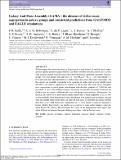Files in this item
Galaxy And Mass Assembly (GAMA) : the absence of stellar mass segregation in galaxy groups and consistent predictions from GALFORM and EAGLE simulations
Item metadata
| dc.contributor.author | Kafle, P. R. | |
| dc.contributor.author | Robotham, A. S. G. | |
| dc.contributor.author | Lagos, C. del P. | |
| dc.contributor.author | Davies, L. J. | |
| dc.contributor.author | Moffett, A. J. | |
| dc.contributor.author | Driver, S. P. | |
| dc.contributor.author | Andrews, S. K. | |
| dc.contributor.author | Baldry, I. K. | |
| dc.contributor.author | Bland-Hawthorn, J. | |
| dc.contributor.author | Brough, S. | |
| dc.contributor.author | Cortese, L. | |
| dc.contributor.author | Drinkwater, M. J. | |
| dc.contributor.author | Finnegan, R. | |
| dc.contributor.author | Hopkins, A. M. | |
| dc.contributor.author | Loveday, J. | |
| dc.date.accessioned | 2018-01-22T09:30:11Z | |
| dc.date.available | 2018-01-22T09:30:11Z | |
| dc.date.issued | 2016-12 | |
| dc.identifier | 252098660 | |
| dc.identifier | 6edf45b4-9ac7-471b-b4b7-280e90811c34 | |
| dc.identifier | 85019751644 | |
| dc.identifier | 000393568200053 | |
| dc.identifier.citation | Kafle , P R , Robotham , A S G , Lagos , C D P , Davies , L J , Moffett , A J , Driver , S P , Andrews , S K , Baldry , I K , Bland-Hawthorn , J , Brough , S , Cortese , L , Drinkwater , M J , Finnegan , R , Hopkins , A M & Loveday , J 2016 , ' Galaxy And Mass Assembly (GAMA) : the absence of stellar mass segregation in galaxy groups and consistent predictions from GALFORM and EAGLE simulations ' , Monthly Notices of the Royal Astronomical Society , vol. 463 , no. 4 , pp. 4194-4209 . https://doi.org/10.1093/mnras/stw2290 | en |
| dc.identifier.issn | 0035-8711 | |
| dc.identifier.other | ArXiv: http://arxiv.org/abs/1609.01800v1 | |
| dc.identifier.uri | https://hdl.handle.net/10023/12549 | |
| dc.description.abstract | We investigate the contentious issue of the presence, or lack thereof, of satellites mass segregation in galaxy groups using the Galaxy And Mass Assembly (GAMA) survey, the galform semi-analytic, and the EAGLE cosmological hydrodynamical simulation catalogues of galaxy groups. We select groups with halo mass 12 ≤ log (Mhalo/h−1 M⊙) < 14.5 and redshift z ≤ 0.32 and probe the radial distribution of stellar mass out to twice the group virial radius. All the samples are carefully constructed to be complete in stellar mass at each redshift range and efforts are made to regularize the analysis for all the data. Our study shows negligible mass segregation in galaxy group environments with absolute gradients of ≲0.08 dex and also shows a lack of any redshift evolution. Moreover, we find that our results at least for the GAMA data are robust to different halo mass and group centre estimates. Furthermore, the EAGLE data allows us to probe much fainter luminosities (r-band magnitude of 22) as well as investigate the three-dimensional spatial distribution with intrinsic halo properties, beyond what the current observational data can offer. In both cases we find that the fainter EAGLE data show a very mild spatial mass segregation at z ≤ 0.22, which is again not apparent at higher redshift. Interestingly, our results are in contrast to some earlier findings using the Sloan Digital Sky Survey. We investigate the source of the disagreement and suggest that subtle differences between the group-finding algorithms could be the root cause. | |
| dc.format.extent | 16 | |
| dc.format.extent | 2036271 | |
| dc.language.iso | eng | |
| dc.relation.ispartof | Monthly Notices of the Royal Astronomical Society | en |
| dc.subject | Galaxies: evolution | en |
| dc.subject | Galaxies: formation | en |
| dc.subject | Galaxies: haloes | en |
| dc.subject | Galaxies: groups: general | en |
| dc.subject | QB Astronomy | en |
| dc.subject | QC Physics | en |
| dc.subject | DAS | en |
| dc.subject.lcc | QB | en |
| dc.subject.lcc | QC | en |
| dc.title | Galaxy And Mass Assembly (GAMA) : the absence of stellar mass segregation in galaxy groups and consistent predictions from GALFORM and EAGLE simulations | en |
| dc.type | Journal article | en |
| dc.contributor.institution | University of St Andrews. School of Physics and Astronomy | en |
| dc.identifier.doi | 10.1093/mnras/stw2290 | |
| dc.description.status | Peer reviewed | en |
| dc.identifier.url | http://arxiv.org/abs/1609.01800v1 | en |
This item appears in the following Collection(s)
Items in the St Andrews Research Repository are protected by copyright, with all rights reserved, unless otherwise indicated.

